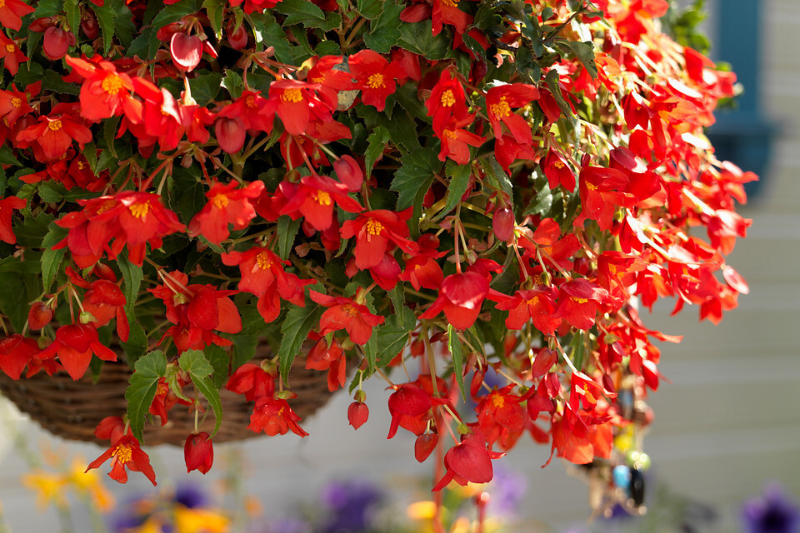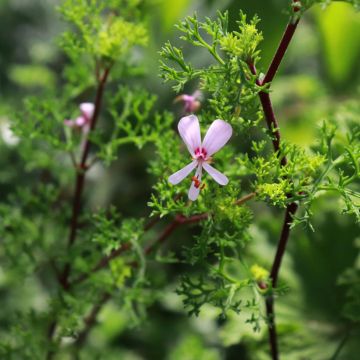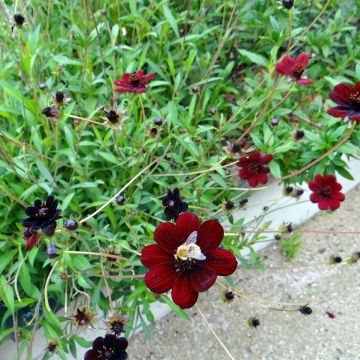

Petunia Conchita Azur


Petunia Conchita Azur - Pétunia hybride retombant bleu azur.
View more pictures
Hide images

Elise A.

The very first flower a few days after planting the plug plant.
Elise A. • 51 FR
Petunia Conchita Azur
Petunia x hybrida Conchita Azur
Garden Petunia, Common Petunia
Beautiful flowers but not prolific enough for my taste. Impeccable service and speed!
Tabitha PESTEL, 18/10/2016
Special offer!
Receive a €20 voucher for any order over €90 (excluding delivery costs, credit notes, and plastic-free options)!
1- Add your favorite plants to your cart.
2- Once you have reached €90, confirm your order (you can even choose the delivery date!).
3- As soon as your order is shipped, you will receive an email containing your voucher code, valid for 3 months (90 days).
Your voucher is unique and can only be used once, for any order with a minimum value of €20, excluding delivery costs.
Can be combined with other current offers, non-divisible and non-refundable.
Why not try an alternative variety in stock?
View all →This plant carries a 6 months recovery warranty
More information
We guarantee the quality of our plants for a full growing cycle, and will replace at our expense any plant that fails to recover under normal climatic and planting conditions.
Would this plant suit my garden?
Set up your Plantfit profile →
Description
Petunia 'Conchita Azur' is a recent variety with a dense and truly trailing habit, producing stems over 60 cm (24in) long, completely covered with single, medium-sized flowers with a dark blue centre fading to sky blue over time. These vigorous plants flower continuously until October, with endless waves of blue in summer flower beds, overflowing from pots and hanging baskets. It thrives in full sun, in fertile, light and moist soil.
Hybrid petunias originate from several plants native to the warm regions of South America. Trailing petunias were discovered by chance in 1989 when a scientist noticed a particularly vigorous wild petunia covered in bright flowers on the edge of a field: Petunia inflata. Crossed with others, this species gave rise to trailing petunias, which were marketed as Surfinias. The trailing Petunia 'Conchita Azur' belongs to the solanaceae family and is closely related to ornamental tobacco, its foliage also contains alkaloids. This plant quickly forms a spreading clump, at least 20 cm (8in) tall and 60-70 cm (24-28in) in diameter, with a trailing habit. It produces cascades of flowers from June until the first frosty nights, provided faded flowers are regularly removed and it is regularly fed. Its medium-sized, cup-shaped flowers are 4.5 cm (2in) in diameter, in azure blue, slightly mauve, then faded blue with a dark centre. The hairy, dark green leaves have entire edges.
No other annual flowering plant has undergone such extensive breeding work for over a century. The results are impressive and petunias rival geraniums in the splendour and duration of their flowering, as demonstrated by this variety. Plant them in large pots or hanging baskets, above walls, wherever their flower-covered stems can cascade. They can also be planted in beds, creating large swathes to edge borders of plants with grey foliage, such as cerastium or artemisia, or to cover the base of roses.
Note: Please be aware that our plug plants are products intended for experienced gardeners: upon receipt, repot and store them in sheltered areas (veranda, greenhouse, cold frame...) at a temperature above 14°C (57.2°F) for a few weeks before planting them outdoors once all risk of frost has passed.
Petunia Conchita Azur in pictures


Flowering
Foliage
Plant habit
Botanical data
Petunia
x hybrida
Conchita Azur
Solanaceae
Garden Petunia, Common Petunia
Cultivar or hybrid
Other Petunia and Surfinia
View all →Planting and care
You can plant your 'Conchita' petunias in the ground or in a pot. If you wish to plant them in the ground, wait until the last heavy frosts have passed (surfinia petunias can tolerate a small late frost). In the meantime, you can grow them on in a pot in a warm and bright place to accelerate their growth. Petunias will bloom from June to October. Plant your Conchita Azur petunias in a sunny or partially shaded location sheltered from the wind. They require light and humus-rich, well-draining soil. Do not overwater them at the beginning of the growing season as they are sensitive to excess moisture. They can tolerate drought but will need regular watering during hot summer periods. Petunias are susceptible to frost (minimum -1°C (30.2°F)). They are floriferous and fast-growing, hungry plants. We recommend feeding them with a liquid fertiliser once or twice a week during the growing season. Remove faded flowers and dry leaves as they appear to keep them looking beautiful and extend the flowering period.
Planting period
Intended location
Care
Planting & care advice
-
, onOrder confirmed
Reply from on Promesse de fleurs
Similar products
Haven't found what you were looking for?
Hardiness is the lowest winter temperature a plant can endure without suffering serious damage or even dying. However, hardiness is affected by location (a sheltered area, such as a patio), protection (winter cover) and soil type (hardiness is improved by well-drained soil).

Photo Sharing Terms & Conditions
In order to encourage gardeners to interact and share their experiences, Promesse de fleurs offers various media enabling content to be uploaded onto its Site - in particular via the ‘Photo sharing’ module.
The User agrees to refrain from:
- Posting any content that is illegal, prejudicial, insulting, racist, inciteful to hatred, revisionist, contrary to public decency, that infringes on privacy or on the privacy rights of third parties, in particular the publicity rights of persons and goods, intellectual property rights, or the right to privacy.
- Submitting content on behalf of a third party;
- Impersonate the identity of a third party and/or publish any personal information about a third party;
In general, the User undertakes to refrain from any unethical behaviour.
All Content (in particular text, comments, files, images, photos, videos, creative works, etc.), which may be subject to property or intellectual property rights, image or other private rights, shall remain the property of the User, subject to the limited rights granted by the terms of the licence granted by Promesse de fleurs as stated below. Users are at liberty to publish or not to publish such Content on the Site, notably via the ‘Photo Sharing’ facility, and accept that this Content shall be made public and freely accessible, notably on the Internet.
Users further acknowledge, undertake to have ,and guarantee that they hold all necessary rights and permissions to publish such material on the Site, in particular with regard to the legislation in force pertaining to any privacy, property, intellectual property, image, or contractual rights, or rights of any other nature. By publishing such Content on the Site, Users acknowledge accepting full liability as publishers of the Content within the meaning of the law, and grant Promesse de fleurs, free of charge, an inclusive, worldwide licence for the said Content for the entire duration of its publication, including all reproduction, representation, up/downloading, displaying, performing, transmission, and storage rights.
Users also grant permission for their name to be linked to the Content and accept that this link may not always be made available.
By engaging in posting material, Users consent to their Content becoming automatically accessible on the Internet, in particular on other sites and/or blogs and/or web pages of the Promesse de fleurs site, including in particular social pages and the Promesse de fleurs catalogue.
Users may secure the removal of entrusted content free of charge by issuing a simple request via our contact form.
The flowering period indicated on our website applies to countries and regions located in USDA zone 8 (France, the United Kingdom, Ireland, the Netherlands, etc.)
It will vary according to where you live:
- In zones 9 to 10 (Italy, Spain, Greece, etc.), flowering will occur about 2 to 4 weeks earlier.
- In zones 6 to 7 (Germany, Poland, Slovenia, and lower mountainous regions), flowering will be delayed by 2 to 3 weeks.
- In zone 5 (Central Europe, Scandinavia), blooming will be delayed by 3 to 5 weeks.
In temperate climates, pruning of spring-flowering shrubs (forsythia, spireas, etc.) should be done just after flowering.
Pruning of summer-flowering shrubs (Indian Lilac, Perovskia, etc.) can be done in winter or spring.
In cold regions as well as with frost-sensitive plants, avoid pruning too early when severe frosts may still occur.
The planting period indicated on our website applies to countries and regions located in USDA zone 8 (France, United Kingdom, Ireland, Netherlands).
It will vary according to where you live:
- In Mediterranean zones (Marseille, Madrid, Milan, etc.), autumn and winter are the best planting periods.
- In continental zones (Strasbourg, Munich, Vienna, etc.), delay planting by 2 to 3 weeks in spring and bring it forward by 2 to 4 weeks in autumn.
- In mountainous regions (the Alps, Pyrenees, Carpathians, etc.), it is best to plant in late spring (May-June) or late summer (August-September).
The harvesting period indicated on our website applies to countries and regions in USDA zone 8 (France, England, Ireland, the Netherlands).
In colder areas (Scandinavia, Poland, Austria...) fruit and vegetable harvests are likely to be delayed by 3-4 weeks.
In warmer areas (Italy, Spain, Greece, etc.), harvesting will probably take place earlier, depending on weather conditions.
The sowing periods indicated on our website apply to countries and regions within USDA Zone 8 (France, UK, Ireland, Netherlands).
In colder areas (Scandinavia, Poland, Austria...), delay any outdoor sowing by 3-4 weeks, or sow under glass.
In warmer climes (Italy, Spain, Greece, etc.), bring outdoor sowing forward by a few weeks.




























































